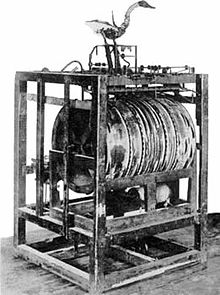- Digesting Duck
-
The Canard Digérateur, or Digesting Duck, was an automaton in the form of a duck, created by Jacques de Vaucanson in 1739. The mechanical duck appeared to have the ability to eat kernels of grain, and to metabolize and defecate them. While the duck did not actually have the ability to do this - the food was collected in one inner container, and the pre-stored feces was 'produced' from a second, so that no actual digestion took place - Vaucanson hoped that a truly digesting automaton could one day be designed.
Voltaire wrote that "without...the duck of Vaucanson, you will have nothing to remind you of the glory of France." ("Sans...le canard de Vaucanson vous n'auriez rien qui fit ressouvenir de la gloire de la France.")
Modern presence
A replica of Vaucanson's mechanical duck, created by Frédéric Vidoni, is part of the numerous works of art exhibited in the Museum of Automatons in Grenoble, France.
The duck is mentioned as the hero of Nathaniel Hawthorne's short story "The Artist of the Beautiful."
A fictitious enhancement of Vaucanson's original duck figures prominently in Thomas Pynchon's historical novel Mason & Dixon.
The duck is used as the symbol for the software company Automatic Duck, Inc.
A replica of the duck was commissioned privately from David Secrett, an automaton maker known for his archer figure.
In 2006, Belgian Conceptual Artist Wim Delvoye introduced the world to his "Cloaca Machine", a mechanical art work that actually digests food and turns it into excrement, finally fulfilling Vaucanson's wish for a working digestive automation. Many iterations of the Cloaca Machine have since been produced; the current iteration sits vertically, mimicking the human digestive system. The excrement produced by the machine is vacuum-sealed in Cloaca-branded bags and sold to art collectors and dealers; every series of excrements produced has sold out.
Further reading
- Riskin, Jessica. "The defecating duck, or, the ambiguous origins of artificial life." Critical Inquiry 29, no. 4 (2003): 599-633.
External links
- Living Dolls: A Magical History Of The Quest For Mechanical Life by Gaby Wood Guardian Unlimited Books, Extracts, Saturday February 16, 2002
- "A Zenith" by Sara Roberts
Categories:- Ducks
- Biomorphic robots
- Historical robots
- 18th-century robots
- Robots of France
Wikimedia Foundation. 2010.


